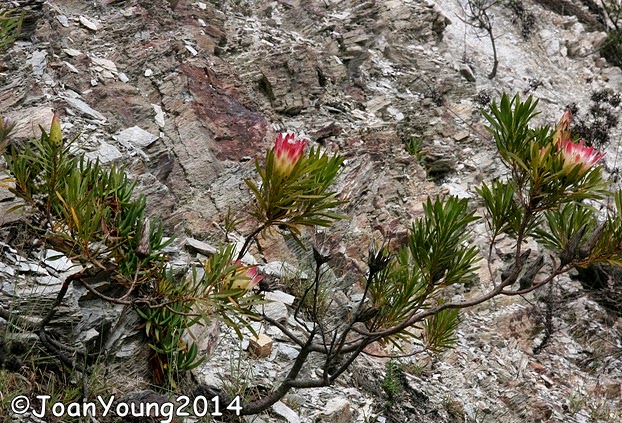Family Proteaceae
Protea repens
was grown under glass in the Royal Collections at Kew in 1774 and flowered
around 1780, the first protea ever to have been flowered in cultivation away
from the Cape. It was also the first protea to have been grown outside in
gardens in Australia, New Zealand and California from about 1890. Protea
repens was the National Flower of South Africa up to 1976.
Protea repens has
been exploited for centuries, as a source of firewood as well as for the nectar
produced by the flowers and more recently by the cut flower industry. The
abundantly produced nectar was collected in the past to be boiled into a sugary
syrup, the so-called 'bossiestroop', an essential component of 19th century
medicine chests in the Cape. The cut flower industry utilises the variation in
flowering time and flower colour and has produced many beautiful hybrids or
varieties, such as 'Guerna', 'Liebencherry', 'Sneyd', 'Sugar Daddy' and
'Venus'. These plants and the cut flowers they produce can be found in
nurseries in New Zealand, Australia, Israel and of course South Africa.
The amazing variety in plant size, habit, flower size and
colour of the genus Protea was the reason it was named after the Greek
god Proteus, who could change his shape at will. The species name of 'repens',
meaning 'creeping' is misleading as Protea repens is an upright, much
branched shrub, which normally grows to a height of 2.5 metres but can reach a
height of 4.5 m. The name is based on descriptions and illustrations by
Boerhaave (1720), which show a very short stem, from which the botanist
Linnaeus assumed that it had a creeping habit, hence the name 'repens'. The
botanist Thunberg later named the same plant Protea mellifera, referring
to the sweet nectar produced by the flowers. However, this much more suitable
name had to make way for the earlier name, so this upright shrub is now called Protea
repens.This sturdy, dense shrub produces fairly large flowers ranging in colour from cream to deep red either during summer or during winter, depending on the variant grown. It is an excellent addition to any "wild-life" garden as the large amount of nectar produced by the flowers attracts birds, bees and other insects. The plants are tolerant to a large variety of growing conditions but will show frost damage at temperatures below -4 degrees Celsius.
Protea repens occurs in the Southern part of South Africa and grows from high in the mountains of the Bokkeveld Escarpment along the South West Cape to East of Grahamstown in the Eastern part of the Cape. Although it mostly occurs on the flats, coastal forelands, lower and middle mountain slopes, it has been found at altitudes up to 1500 metres and can be found scattered in between the other fynbos plants or in dense stands. Its conservation status is almost ubiquitous. The flowering period varies from winter flowering in the Western part of the range to summer flowering in the Eastern part. The flower colour also varies, from a creamy white to white touched with pink, to the deep red varieties used by the cut flower industry.
The "flowers" of Protea repens are actually flower heads with a collection of flowers in the centre, surrounded by large colourful bracts. The shape of the flowers is very distinctive, chalice-shaped, and forms an inverted, brown "ice-cream cone" seedhead. The flowers are pollinated by Scarab Beetles and Protea Beetles and many other insects, as well as by birds. The birds are attracted by the nectar as well as by the insects visiting the flowers. The development from opening flower to complete closed flower takes from six to eight weeks and the seed develops over the next seven months.
The flowers are semi-serotinous, some opening after seven months and dispersing the seeds and others staying on the plants for a number of years. Only about 20% of the flowers actually develop into viable seeds. The seeds in the seedheads are damaged by the larvae of many different insects, after two years less than 16% of the seed is undamaged.
Info: http://www.plantzafrica.com




